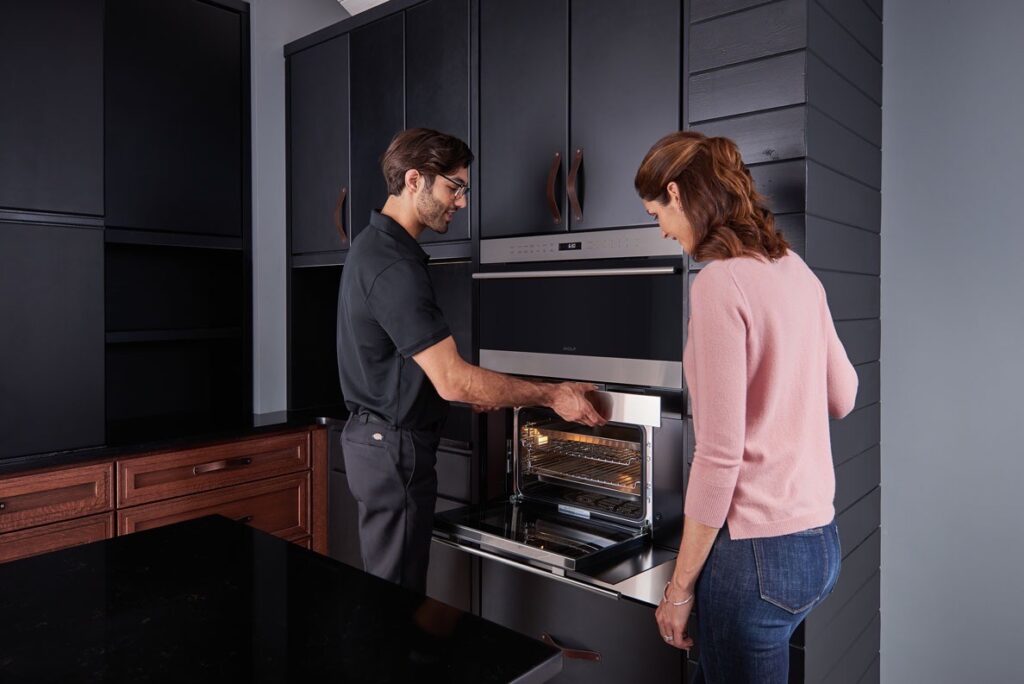Why Tucson’s Smartest Homeowners Prioritize—Use Dependable Refrigeration & Appliance Repair Service SubZero Repair
Why Tucson’s Smartest Homeowners Prioritize—Use Dependable Refrigeration & Appliance Repair Service SubZero Repair
Blog Article
The Ultimate Guide to Do It Yourself Appliance Repair Work Strategies
From refrigerators to dishwashing machines, recognizing how to fix and fix these devices can save you time and cash. Are you all set to uncover essential techniques that will equip you to deal with fixings with confidence?
Recognizing Usual Appliance Troubles
When you rely on your home appliances, it can be discouraging when they instantly quit functioning or act up. Comprehending common device troubles can help you fix concerns efficiently.
If your stove isn't home heating, defective components or thermostat concerns might be responsible. Dish washers frequently experience problems with water drainage, so see to it the filter is clean and the drain tube isn't kinked.
Likewise, pay attention for uncommon noises; they commonly indicate mechanical issues. By acknowledging these indications, you can conserve time and potentially prevent costly repair work. A little understanding goes a long means in preserving your home appliances, so remain informed to maintain whatever running smoothly.
Vital Tools for Do It Yourself Fixes
Prior to diving right into do it yourself device repairs, it is essential to collect the right devices to assure the procedure goes smoothly. Start with a great set of screwdrivers, consisting of both flathead and Phillips, as they're essential for opening most devices. You'll also desire a set of pliers for grasping and twisting wires or small components.
Don't neglect a multimeter; it assists you test electrical components and detect problems properly. A socket set comes in handy for loosening or tightening up bolts, while an energy blade can be helpful for cutting wires or opening product packaging.
Ultimately, take into consideration having a flashlight handy to light up dark rooms inside your appliances. With these essential devices, you'll be fully equipped to tackle numerous fixings, conserving both money and time. So, collect your gear and obtain prepared to roll up your sleeves!
Safety First: Preventative Measures to Take
Prior to you start any type of home appliance repair service, it's vital to prioritize safety. Make sure you use individual safety tools, separate the power resource, and keep your workplace arranged. These simple preventative measures can assist prevent crashes and guarantee a smoother repair process.

Personal Safety Tools
Safety and security equipment is a vital part of any kind of DIY home appliance fixing job. You must constantly use safety and security goggles to shield your eyes from dust and debris. A strong set of gloves will protect your hands from sharp edges and hazardous products. Think about making use of a mask if you're dealing with chemicals or dust, guaranteeing you take a breath safely while working. Steel-toed boots are also a clever selection, particularly when raising hefty home appliances. Do not fail to remember to wear long sleeves and trousers to secure your skin from possible injuries. By prioritizing individual protective devices, you'll greatly decrease the threat of injuries and accidents. Bear in mind, being prepared with the best gear keeps you risk-free and concentrated on completing your repair efficiently.
Power Resource Disconnection
To assure a risk-free DIY appliance fixing, disconnecting the power source is important. Before you begin any kind of job, you need to transform or disconnect the appliance off the circuit breaker. This straightforward step avoids electrical shocks and guarantees that you can concentrate on the repair service without bothering with unintended activation. Constantly ascertain that the home appliance is off by testing it with a voltage tester. If you're managing larger appliances, like a washer or dryer, ensure to protect the power cord and avoid any call with water. Remember, safety initially! When you're positive that the power is disconnected, you can confidently proceed with your repairs, recognizing you have actually taken the essential safety measures to safeguard yourself.
Workplace Organization
An efficient job area can make all the difference in your DIY home appliance fixing job. Begin by clearing your workspace of clutter to prevent mishaps and disturbances. A clean room not just enhances performance but likewise keeps you safe while you function on your device repair work.
Step-by-Step Guide for Fridge Fixes
When your refrigerator begins acting up, it can be irritating, however tackling the problem yourself can save you time and cash. Unplug the refrigerator to ensure safety. Look for typical concerns like temperature level changes or unusual noises. If it's not cooling, evaluate the thermostat setups; they may be established too expensive. Next off, clean the condenser coils, which commonly accumulate dust and debris. For a noisy refrigerator, check the follower and confirm it's not obstructed.
If there's water merging within, evaluate the door seals for damage or dust, and tidy them if needed. For ice accumulation, clear the defrost drain. Connect the refrigerator back in and check it for a couple of hours when you have actually addressed the concern. If the trouble lingers, you may require to replace a malfunctioning component, like the compressor or fan motor. Keep in mind, do not wait to speak with the guidebook or seek specialist assistance if required.
Taking Care Of Cleaning Equipment Concerns
Much like fridges, washing makers can provide their very own collection of obstacles, but several issues can be resolved with a little troubleshooting. Initially, if your equipment won't begin, examine the power cable and confirm it's connected in. Next off, evaluate the door latch; a faulty latch can prevent the cycle from beginning. If you notice unusual noises throughout procedure, it could be due to international things stuck in the drum or the drain pump.
Tightening up these can frequently resolve the issue. Normal maintenance, like cleaning the filter, can stop several concerns from arising.
Troubleshooting Ranges and ovens
Just how can you troubleshoot common problems with your stove or stove? Start by examining the power supply. Make specific it's plugged in and the circuit breaker is not tripped. Validate the gas shutoff is open if it's a gas cooktop. Next, test the burners: if they don't fire up, clean up the igniter and check for obstructions in the heater ports.
If your oven isn't home heating, inspect the temperature setups and confirm the door seals snugly. A faulty heating component might also be the offender; you might need to change it if it's harmed.
For irregular see post cooking, turn your frying pans and consider using an oven thermostat to confirm exact temperatures. Lastly, if you hear uncommon noises or scent gas, transform off the home appliance right away and seek advice from an expert. By complying with these actions, you can recognize and deal with several usual stove and cooktop problems effectively.
Fixing Dishwashing Machines Made Easy
When your dishwashing machine starts breaking down, it can be frustrating, however addressing common issues isn't as hard as it seems. You'll discover step-by-step troubleshooting techniques that will aid you pinpoint the problem, in addition to the crucial devices you'll require to tackle repairs on your own. Let's make fixing your dishwashing machine a wind!
Common Dishwashing Machine Problems
While dishwashers are designed to make your life simpler, they can often run right into usual issues that leave you feeling discouraged. One constant trouble is poor cleaning performance; this frequently happens due to clogged spray arms or dirty filters. You may also observe water pooling at the bottom, which can indicate a faulty drainpipe or a kinked pipe. It might be an easy problem with the latch device or door seal if your dishwashing machine's door will not lock. In addition, unusual noises can signify loosened components or damaged elements. Ultimately, if you scent something odd, it may be time to look for food particles or a malfunctioning motor. Attending to these concerns early can conserve you time and inconvenience down the roadway (Dependable Appliance For SubZero Freezer Repair).

Step-by-Step Troubleshooting
Before diving into repairs, it's crucial to determine the particular problem your dishwashing machine is dealing with. If your dishwasher will not begin, check the power supply and door lock. By carefully attending to each potential jenn air refrigerator repair concern, you can identify the trouble and take the needed actions to fix it, making your dishwashing machine feature like new once again.
Necessary Fixing Tools
Having the right tools at your disposal can make all the distinction when repairing your dishwashing machine. Begin with a screwdriver collection, as you'll commonly require both Phillips and flathead options. A multimeter's important for identifying electric problems, while pliers can help you hold and manipulate numerous parts. Do not fail to remember a pail or towels for any water splashes during repairs.
If you're taking on obstructions, a drainpipe serpent or a wet/dry vacuum will be indispensable. You may likewise desire a degree to guarantee your dishwasher's correctly lined up. Security gear like safety glasses and gloves will protect you while you work. With these essential devices, you'll be well-appointed to tackle any kind of dishwashing machine fixing difficulty that comes your way.
Frequently Asked Concerns
If an Appliance Is Well Worth Repairing?, just how Do I Figure out.
To figure out if a device's worth fixing, consider its age, repair expenses, and present worth. You could desire to spend in a brand-new design rather - Best Sub-Zero Service Near You Dependable Refrigeration & Appliance Repair Service. if repair work exceed half the replacement cost.
Can I Find Replacement Components Locally for My Device?
Yes, you can often discover replacement components in your area for your home appliance. Inspect hardware stores, appliance service center, or regional classifieds. Do not fail to remember to bring the design number to you can look here ensure you get the appropriate part!
When Fixing Appliances?, what Common Mistakes Should I Prevent.
When repairing devices, prevent hurrying via diagnostics, disregarding safety precautions, or utilizing incorrect devices. Do not miss reviewing handbooks or enjoying tutorials; they provide essential guidance. Hold your horses and extensive to assure successful fixings and stop additional damage.
Exactly how Lengthy Does a Common Do It Yourself Appliance Fixing Take?
A typical DIY device repair work usually takes one to 3 hours, depending upon the complexity. You'll desire to gather your tools and products first, and follow instructions carefully to prevent unneeded delays.
Are There Any Type Of Guarantees for DIY Device Repair Works?
When you deal with do it yourself device repairs, warranties typically do not cover your job. Some manufacturers may honor warranties for components you change. Always inspect your home appliance's guarantee terms before starting any repairs to prevent concerns.
Prior to diving into Do it yourself device repairs, it's crucial to gather the right devices to assure the process goes efficiently.Before you start any home appliance repair service, it's necessary to focus on security.To assure a risk-free DIY device fixing, detaching the power resource is necessary.An efficient work area can make all the difference in your DIY home appliance repair service project. Always check your home appliance's warranty terms before beginning any type of repair services to avoid problems.
Report this page